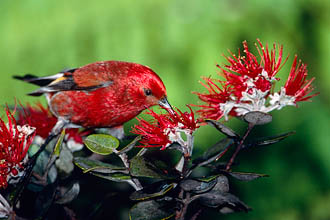
Himatione sanguinea
TAXONOMY
Himatione sanguinea Gmelin, 1788.
OTHER COMMON NAMES
French: Picchion cramoisi; German: Apapane; Spanish: Apapane.
PHYSICAL CHARACTERISTICS
5.25 in (13.3 cm); 0.5–0.56 oz (14–16 g). Plumage bright crimson
with black wings and tail, white undertail and abdomen;
long, downcurved bill.
DISTRIBUTION
Not threatened. Most abundant honeycreeper species, also one
of the most conspicuous. Common in forests over 3,300 ft
(1,000 m) on Hawaii, Maui, Kauai, and Oahu, rare or extinct
on Molokai and Lanai.
HABITAT
Forests over 3,300 ft (1,000 m).
BEHAVIOR
Social, gather into sizeable flocks and range about forests in
search of blooming ohia. Calls varied, include squeaks, whistles,
raspings, clickings, and musical trillings. Blunt wing tips
make a loud and distinctive noise in flight, probably for group
cohesion.
FEEDING ECOLOGY AND DIET
Flocks are lively and obvious when feeding on nectar of flowering
ohia trees and flying considerable distances between forest
patches of seasonal blooms. Flocks can become as dense as
3,000 individuals per 0.4 sq mi (1 sq km) when ohias are
blooming. Then groups fly about looking for patches of ohia
trees in bloom, and descend to drink nectar and glean insects.
REPRODUCTIVE BIOLOGY
Breed throughout year, mostly during February to June, coinciding
with the seasonal availability of ohia nectar.
CONSERVATION STATUS
Not threatened. However, apapane are primary carriers of
avian malaria and avian pox, making them major vectors of
these diseases, since they fly so extensively.
SIGNIFICANCE TO HUMANS
None known.
Photo Gallery of - Apapane




 Animalia Life
Animalia Life